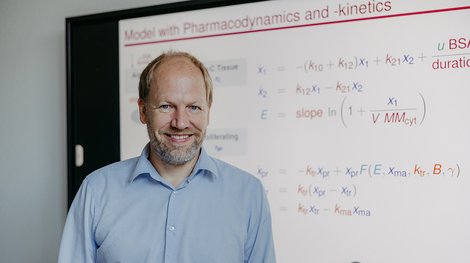Treating leukemia with the help of math

Researchers from the Institute for Mathematical Optimization at Otto von Guericke University Magdeburg have developed a computer model that will allow leukemia patients to be given more personalized and less invasive treatment in the future. The researchers measure the number of white blood cells a patient has and create a digital twin from the patient's personal data which they use to simulate on the computer the growth of the healthy and diseased cells in each individual patient.
The digital twins allowed the researchers to run a virtual study in which they compared different treatments under identical conditions and were able to reproduce the results from a current clinical study. In another virtual study, the team simulated the best possible treatment for each individual virtual twin. Using the data from 14 patients, the mathematical model enabled the treatment times and doses in 13 cases to be improved to such an extent that a much less severe treatment could be simulated for the affected person. "For example, in the case of one of the patients, two treatment sessions in quick succession with lower doses treated the cancer cells just as effectively, but with a significantly reduced impact on the patient's immune system," explained Professor Sebastian Sager, head of the research project.
Until now, all patients have had chemotherapy according to a fixed schedule with the aim of killing the diseased cells without weakening the immune system too significantly. "The success of this type of treatment naturally varies from one person to another. As a mathematician, I asked myself why the principle of dynamic systems could not be applied in the field of medicine by taking the interaction of influence and effect into account in the treatment," explained Professor Sager. "Everyone is familiar with the principle of a swing. The moment when you push the swing influences how well it moves. The principle is ultimately the same with chemotherapy."
The goal of his research is to give the chemotherapy at precisely the moment when it will be most effective and treat the cancer while reducing the impact on the healthy cells. "This is hugely important for the success of the treatment, because many affected people are highly susceptible to infection because of their weakened immune system and can often die as a result."
Simulating the ideal treatment times
The team developed a model for this purpose that allows the best possible time for the start of the treatment to be predicted for each individual patient. On the basis of each patient's data, mathematical equations can be used to describe the influence of the chemotherapy on the different stages of the cells. "We can now replicate how the values will change depending on when and at what intervals the treatment is given," explained Sager. "By taking blood samples regularly, we can measure the number of white blood cells and leukemia cells. Once we have a certain amount of data, we can simulate how this will change over time for each patient."
In order to replicate the dynamics of the process as effectively as possible, data from new blood samples must be obtained at intervals of just a few days. "It goes without saying that the more data we have the better the system works," said Professor Sager. "By using the measurements from one treatment cycle, we can already predict the next two cycles very accurately. This allows the hospital team to plan the treatment sessions and put the model into practice in a clinical setting."
The simulation is intended only as a recommendation for physicians that will make their work easier. The decision about the structure of the treatment must ultimately still be made by the medical staff. In addition, the mathematical model can currently only be used with the standard type of treatment. As there are several different types of chemotherapy that can be combined in new ways for the benefit of patients, in the next stage of the project the researchers plan to add these mechanisms to their simulations in collaboration with Inna Lavrik, Denis Schewe and Dimitrios Mougiakakos from the Faculty of Medicine. In the best-case scenario, an application could be submitted for a larger study with control groups during the next year. "If everything goes to plan, we can run this study in 2024 and finally evaluate in practice whether the predictions are correct," said Professor Sager in conclusion.
Source: www.ovgu.de

